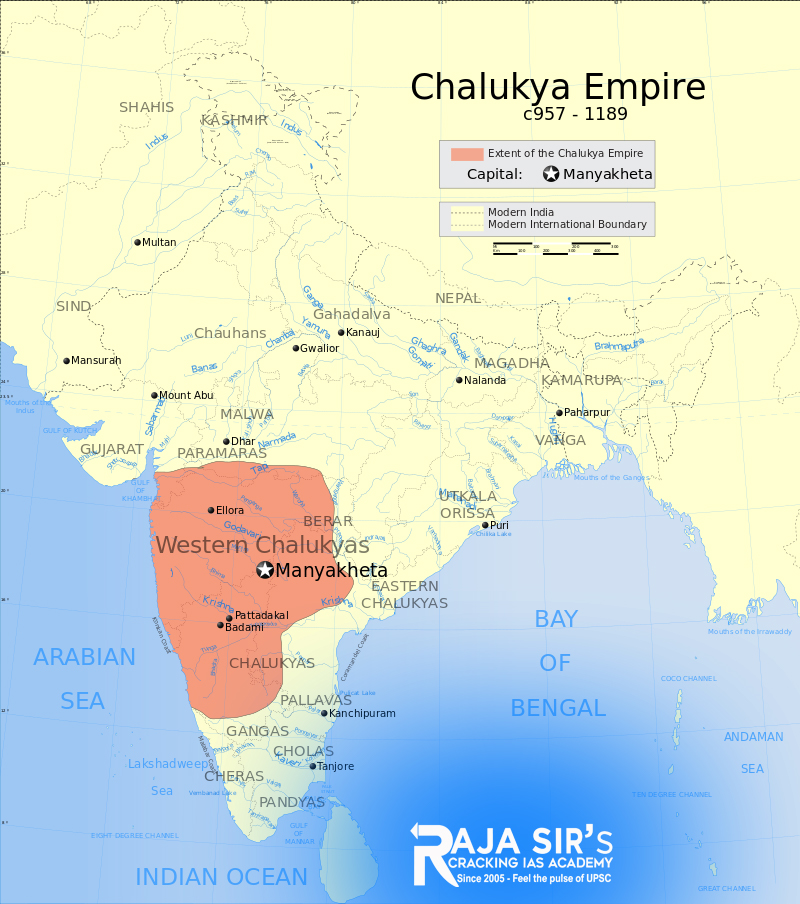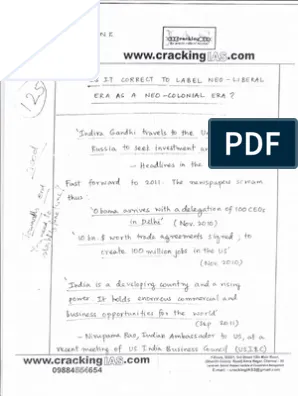|
Chalukyas of Badami - Rulers and their Contributions
|
|
|
Period: AD 543 - AD 755
|
Capital: Badami (Vatapi)
|
|
- They set up their kingdom in western Deccan, with the capital at Vatapi (modern Badami in Karnataka).
- They were involved in a political struggle with Pallavas that continued with ups and downs for over a hundred years.
|
|
|
Pulakesin I (540- 566 AD)
- Established city of Vatapi
- First sovereign ruler of the Chalukya dynasty.
- Titles: Vallabheshwar, Satyashraya, Rana-vikrama, Rajasimha etc.
- Religion: Performed Ashvamedha sacrifices, thus followed Vedic religion.
- Inscriptions: Badami rock inscription and Amminabhavi stone tablet inscription talks about Pulakesin I.
- Pulakesin I was followed by his son Kirtivarman I
|
|
|
Kirtivarman I (566-597 AD)
- Aihole Inscription: It states that Kirtivarman was “the night of doom” for the Nalas, Mauryas of Konkan and the Kadambas.
- Conquest of Konkan: Brought the vital port of Goa, or Revatidvipa, into the growing empire.
- Inscriptions: Godachi copper plate inscription talks about Kirtivarman I.
|
|
|
Pulakesin II (608- 642 AD)
- The kingdom rapidly rose to prominence during his reign.
- Titles: Satyashraya, Bhattaraka, Parameshvara and Maharajadhiraja
- Pulakeshin''s subjugation of the Vishnukundins (allies of the Pallavas) brought him into conflict with the Pallavas.
- Battle of Pullalur, AD 618-19: He defeated and killed the Pallava king Mahendravarman-I.
- Aihole inscription: He defeated Harshavardhana in AD 630 and acquired the title ‘Dakshinapatheshvara’ (lord of the south).
- Hsuen Tsang calls Pulakeshin''s kingdom ‘Mo-ho-la-cha’, providing evidence of Pulakeshin''s success against Harsha.
- Battle of Vatapi, AD 642: He was defeated and killed by the Pallava king Narasimhavarman I.
- Ajanta Cave 1: A painting depicts the Sassanian ambassadors in his court. He maintained good relations with the Sassanian empire, which later led to the influx of Zoroastrians during the rise of Islam.
- Religion: Lohner and Pimpalner copper-plate inscriptions attest that he was a Vaishnavite.
- Religious tolerance: He was also tolerant of other faiths like Shaivism and Buddhism.
Contribution of Pulakesin II to Art, Architecture and Literature:
- Several of his inscriptions begin with salutations to Vishnu and bear seals with emblems that feature Varaha, an incarnation of Vishnu.
- The construction of the Shaivite shrines, now called the Upper Shivalaya, the Lower Shivalaya, and Malegitti Shivalaya, started during his reign.
- The Meguti Jain temple at Aihole was also built during his reign by Ravikirrti, who composed the Aihole inscription engraved on the wall of this temple.
The Aihole prashasti inscription, composed by Pulakeshin''s court poet Ravikirtti, records the construction of a Jinendra temple by Ravikirtti and lists Pulakeshin''s military achievements.
|
|
|
Vikramaditya I (644-681AD)
- After the death of Pulakesin II, he restored order in the fractured kingdom and made the Pallavas retreat from the capital Vatapi.
|
|
Chalukyan Art and Architecture
|
Temple Architecture
- Vesara Style: Mixture of Nagar and Dravida styles.
- This style originated and flourished at Aihole, Badami and Pattadakal.
- Important sites: Pattadakal, Aihole, Badami.
- Cave Temples:
- Found in Ajanta, Ellora and Nasik.
- They are monolithic and excavated in sloppy hills.
- They are Brahmanical dedication and Buddhist in style and technique.
|
|
Pattadakal (Raktapura) Group of Monuments (West Bank of Malprabha River)
- Pattadakal: Ten temples built in the seventh and eighth centuries, generally dedicated to Shiva, the most celebrated of which are the Papanatha temple (AD 680) and the Virupaksha temple.
- Elements of Vaishnavism and Shaktism theology and legends are also featured.
- Style: Fusion of two major Indian architectural styles, one from north India (Rekha-Nagara-Prasada) and the other from south India (Dravida-Vimana).
- The Ten Temples: Kadasiddheshwar Temple, Jambu Lingeshwara Temple, Galaganatha Temple, Chandrashekhara Temple, Sangameshwara Temple, Kashi Vishwanath Temple, Mallikarjuna Temple, Virupaksha Temple, Papanath Temple and Jain Narayana Temple.
- Papanath Temple: Has a low and stunted tower in the northern style.
- The site, states Archaeological Survey of India, is mentioned in texts by Srivijaya and is referred to by Ptolemy as "Petirgal" in his Geography.
- UNESCO description: Pattadakal as "a harmonious blend of architectural forms from northern and southern India".
- Stones used: Structures were built using the sandstones found abundantly locally at Pattadakkal. Some of the sculptures are carved from polished black granite.
|
|
Badami Temples
- Complex of Hindu and Jain cave temples.
- Caves 1-4:
- Sandstone Formation.
- Cave 1: Tandava-dancing Shiva as Nataraja
- Bhutanatha group of temples:
- Along Agasthya Lake.
- came under the influence of Jains for a while. Later, it was taken over by the Lingayats, who installed a Shiva Linga in the shrine and a Nandi in front.
- Style: Blend of North Indian and early South Indian temple architecture.
- The Mallikarjuna Temple:
- Lies northeast of the lake and belongs to the period of the later Chalukyas, the Chalukyas of Kalyani.
- It has the tiered pyramid structure characteristic of Western Chalukya Architecture.
- Shikhara: Dravidian type.
- All the Early Chalukyan caves and temples in Badami, except Upper Shivalaya, are nirandhara structures.
|
|
Virupaksha Temple
- Largest of the Pattadakal Monuments.
- Built-in 740 AD by Queen Lokamahadevi to commemorate her husband''s victory over the kings from the South.
- Style: Purely Southern style.
- Has a very high square and storeyed tower (shikhara).
- Temple walls represent scenes from the Ramayana.
- It is also known as “Sri Lokeshwara Mahashila Prasada”, honouring queen Lokamahadevi who commissioned the temple.
- Facing east, this temple has on plan a square sanctum (garbhagriha) with a circumambulatory path (pradakshina patha), an antarala with two small shrines for Ganesa and Mahishamardini facing each other in front.
- The Tower: Above the sanctum is a three-storey pyramidal structure, with each storey bearing motifs that reflect those in the sanctum below.
- The Nandi-Mandapa, situated east of the temple, is a square pavilion open on all four sides. It houses a large image of Nandi on a raised floor.
- Carvings on Sanctum Walls: Depict images of Shaivism, Vaishnavism, and Shaktism deities.
- Themes such as Narasimha and Varaha (Vaishnavism), Bhairava and Nataraja (Shaivism), and Harihara (half Shiva-half Vishnu).
|
|
Aihole Group of Temples (Along Malprabha River)
- Mainly flourished from the reign of Pulakesin I to Pulakesin II.
- There are several groups of temples and two cave shrines dotting the landscape.
- Ravanphadi cave:
- Consists of a mandapa, garbhagriha and two side galleries flanking Mandapa.
- A 6th-century artwork showing dancing Shiva (Nataraja) with Parvati, Saptamatrikas or seven mothers of Shaktism tradition, Ganesha and Kartikeya.
- Two layouts: Sandhara (with circumambulatory path) and Nirandhara (without circumambulatory path).
- Several superstructures:
- Shikhara: Tapering superstructure of discrete squares.
- Mundamala: Temple without superstructure, literally, garland with a shaved head.
- Rekha-Prasada: Smooth curvilinear superstructure also based on squares prevalent in northern and central India.
- Dravidian Vimana: Pyramidal style of southern India) and,
- Kadamba-Chalukya Shikhara: A Fusion style.
- Guadar Gudi
- Garbhagriha is centrally located.
- Sandhara structure.
- Has mundamala shikhara.
- Temples like Huchhimalli gudi and Huchhapayya gudi signify development in the Rekha-prasada type of shikhara.
- Durga temple: a rare example of an apsidal plan in early Chalukyan temples. It has a Sandhara plan.
- Aihole is the ‘cradle of Indian temple architecture’.
- Most temples are Brahmanical, but there are a few Jain temples also.
- Blocks of stone were used for vertical construction.
- Unique Shikharas: The curvilinear and pyramid-like shikhara developed here, not developed in the south.
- One Buddhist monument in Aihole, on Meguti Hill.
- Jain Monuments: Aihole preserves four collections of about ten Jain monuments from the 6th to 12th century AD, associated with the Meena Basti.
- These are found on the Meguti hill, Chanranthi matha, Yoginarayana complex and an early Jaina cave temple
|
|
Lad Khan Temple (Aihole)
- Also known as Chalukya Shiva Temple.
- Originally dedicated to Vishnu.
- Style: The temple was built in a Panchayatana style (central shrine surrounded by four other shrines).
- Special Feature: It starts with a rectangular structure and ends with a square structure.
|
|
Paintings
- Paintings are found in a cave temple dedicated to Vishnu in Badami.
- Chalukyas adopted the Vakataka style in painting.
- Many of the paintings are of incarnations of
Vishnu.
- The most popular Chalukya painting is in the palace built by King Mangalesan (597-609).
- It is a scene of the ball being watched by members of the royal family and others.
|
Chalukyan Literature
|
|
|
- Aihole Inscriptions (by Ravikirti)
|
- Sanskrit inscription at Meguti Jain temple in Aihole.
- Language: Chalukyas used Sanskrit in pillar inscriptions such as Aihole and Mahakudam.
|
|
|
- It mentions Kannada as the local Prakrit, meaning the people’s language, and Sanskrit as the language of culture.
|
|
|
- A grammar work authored by the chieftain of Pulakesin II in Sanskrit.
|
|
|
- During this period, the ‘Tripadi’ form of poetry existed.
- One of the poems in the inscription of Kappe Arabhatta of Badami is in Tripadi form.
|
|
|
- It was written by Pulakeshi II’s daughter-in-law, Vijjika, a poetess.
|
Administration under Chalukyas of Badami
- Paternalistic Control: Chalukyas of Badami exercised Paternalistic control over the village administration, which was unlike the administrative practice of South India.
- King: Actively involved in the administration. King was the head of administration and highest judicial authority. Most of the Chalukyan kings worked for the welfare of the people.
- Council of Ministers: There was a council of ministers to advise the king and to help him in administration.
- Mahamatya: The Prime Minister was called Mahamatya:
- Division of Kingdom: The kingdom was divided into districts called ‘Vishya’ and ‘the Vishayadhapati’.
- Village autonomy: Absent under the Chalukya, unlike Pallavas and Cholas
- Maritime Power: Chalukyas were great Maritime power; Pulakeshin II had 100 ships under his control and a small standing army.
Society and Religion under Chalukyas of Badami
- The period was an era of the revival of Hindu culture and spirituality.
- Importance was given to Vedic rites and rituals.
- The Vaishnavism, Shaivism, Shakta cults and Jainism had received generous encouragement from the kings.
- Hsuen Tsang: Mentioned the decline of Buddhism in western Deccan. But Jainism was steadily on the path of Progress. Ravikirti, the court poet of Pulakesin II, was a Jain.
- Women were respected in society.
Economy under Chalukyas of Badami
- Income from Land: The state income from land seems very limited since most of the land was rocky and not fertile.
- Trade and Commerce: The earnings from the trading activities were also not considered since trade and commerce in India during this period was generally declining.
- Plundering: Chalukyas resorted to frequent invasions and plunder of the neighbouring territories due to the poor state of the economy. The mutually destructive Chalukya-Pallava conflict can be properly understood only in this background.
Decline of Chalukyas of Badami
- After the death of Pulakesin II, Badami Chalukyas went into a brief decline due to internal feuds.
- Continued friction with Pallavas and their occupation of Badami for thirteen years made Chalukyas weak.
- The Chalukyas were in continuous wars with Rashtrakutas in later times.
- The Rashtrakutas replaced the Chalukyan rule in Badami in about 750 CE when Rashtrakuta feudatory Dantidurga gave a final blow and defeated the Chalukyan king Kirtivarman II.
|










 Latest News
Latest News
 General Studies
General Studies